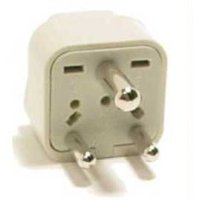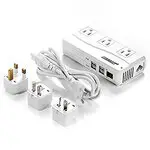How to use plugs from Afghanistan in Brazil
Plugs, sockets, adapters and other information needed for travelling from Afghanistan to Brazil in this page. If you want a report for other countries, re-start the wizard to find to electric adapters for your trip here.
Quick Chart at-a-glance
| Afghanistan | Brazil | ||
|---|---|---|---|
| Voltage: | 240V. | 110V, 220V. |
|
| Plugs Type: | C, D, F. | A, B, C, I, N. |
|
| Hertz: | 50Hz. | 60Hz. |
|
If you are electrical savvy, perhaps the previous chart is all you need. If this is not the case, you can continue reading and discover what the chart is saying!
Plugs and Sockets at each country
In Afghanistan the following plugs are used: (includes Kabul, Herat, Mazar-e Sharif, Kandahar, Jalalabad, Eshkashim, Faizabad.)

|

|

|
| Plug Type C | Plug Type D | Plug Type F |

|

|

|
| Outlet Type C | Outlet Type D | Outlet Type F |
... and in Brazil you will use: (includes Brasília, Rio de Janeiro, São Paulo, Salvador, Belo Horizonte, Recife, Manaus.)

|

|

|

|

|
| Plug Type A | Plug Type B | Plug Type C | Plug Type I | Plug Type N |

|

|

|

|

|
| Outlet Type A | Outlet Type B | Outlet Type C | Outlet Type I | Outlet Type N |
Considerations for Brazil
Multiple readers have reported that Brazil uses mostly type "C" and 220V (hotels and big cities). Officially the plug type "N" is the definite and standard nowadays, it can be used with plugs type "C". How much and and to what extend the standard is enforced is unknown to us and it will depend on where you go, expect high variance in its enforce.
Considering Brazil is a big country, it might be possible your location might be using 110V and flat type plugs (A & B). Sockets type "I" are less common but still possible to find them, i.e. in an air-con. We keep the lesser common outlet-types and voltages in our database for your consideration.

Tucano
Voltage
Take extreme care: the electric network is not homogeneous
Different voltages are used within the countries. So perhaps different voltages are used in different regions or cities. You will have to exercise extreme caution about this. Before pluging any electric device, you should check your device voltage and you must ask a local for the voltage used in the electric network. If you move to different city or region, you should ask again. Using electric devices in different voltage network could incurr in a broken device and even fire. Please read further the page for more information.
On the positive side, nowadays many devices will switch automatically to the network voltage and they will work just fine, i.e. mobile phone chargers are typically multi-voltage (but please, do actually check your own).
High-power devices don't usually handle different voltages due to the high-currents involved i.e. anything that its main purpose involves generating heat (or cold) like hair driers, baby bottle warmers, kettles, etc. On the contrary, modern low-power devices are likely to auto-detect and auto-adapt to different voltages i.e. usb chargers, laptop chargers, etc.
You might either need a step up voltage converter, a step down voltage converter, or maybe, nothing at all. When a country electronic grid is not homogenous, there is not much we can help but ask you to exercise caution.
Plugs Type
Some connectors are used in both countries
You will be able to plug the devices directly in Brazil (please read other sections of this reports in regards to voltage, etc.). Perhaps you will need adapters for some sockets, but it is usually easier to find adapters at destination if your plug is already being used in the country. Sometimes different cities uses different systems, you might need to do a bit more of research. If you find more information please let us know.
Adapters
Lists of adapters you can use in your travel:
Adapter: generic

|

|
| Front | Back |
This adapter allows you to use plugs type: A, B, C, D, E, F, G, H, I, J, K, L, M, N into outlets type: B.
Adapter: generic

|

|
| Front | Back |
This adapter allows you to use plugs type: A, B, C, D, E, F, G, H, I, J, K, L, M, N into outlets type: I.
Adapter: generic

|

|
| Front | Back |
This adapter allows you to use plugs type: A, B, C, D, E, F, G, M into outlets type: I.
Adapter: generic

|

|
| Front | Back |
This adapter allows you to use plugs type: C, D, E, F, G, M into outlets type: A, B.
This adapter is probably illegal in some countries, we put it here for educational purposes; it does not have earth connection but it allows earthed plugs to be connected to it. It has no finger-terminal protection. Try to go for a more expensive and safer alternative.
Adapter: generic

|

|
| Front | Back |
This adapter allows you to use plugs type: C, E, F into outlets type: A, B.
Simple, small and cheap. You can buy half a dozen of them for almost no money and they will not occupy space in your travel bag. its drawback, it does not have earth-connection but it might not be required for some devices.
Adapter: generic

|

|
| Front | Back |
This adapter allows you to use plugs type: A, B, D, G, I, M into outlets type: C, E, F, L.
This adapter has a safety protection so you don't plug only one terminal into the adapter while touching the other with your finger, because it is generic, when you buy it pay attention to this safety mechanism. Overall a good adapter that has the earth connection pass-though (notice the metallic connector on the side.)
Adapters you can buy
You can buy the following multi-purpose adapters from Amazon. Please also take a look at the recommended gadgets for your trip.
Hertz
No equal Hertz
This is not a big issue. Unless you are using an electric alarm clock or some motors when speed is an issue. Explanation: Some alarm clocks uses the frequency of electricity network to measure time. So, time shifts could be experimented. Almost every home electronic device works perfectly with different Hertz.
Finally, by the way ...
We are revamping the blog! Visit our new blog here.
↬ a link from your website helps too.




